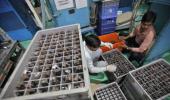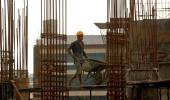At all India level, per capita income will decline by 5.4 per cent in FY21 to Rs 1.43 lakh, the report said.

Post COVID-19 pandemic, the inequality gap in the country will narrow down, as income of rich states is likely to decline more than the poor states, according to an SBI research report- Ecowrap.
At all India level, per capita income (PCI), which is a measure of the earnings per person in a nation or geographic region, will decline by 5.4 per cent in FY21 to Rs 1.43 lakh, the report said.
“We expect that the inequality gap in India will narrow down post-COVID pandemic as decline in income of rich states will be much greater than the decline in income of poor states,” the SBI's research report said.
A similar type of experience of decline in inequality was witnessed in Germany after the collapse of the Berlin war (1989), it said.
The report said this decline in PCI is higher than the nominal GDP decline of 3.8 per cent.
Globally also, the fall in per capita GDP of 6.2 per cent in 2020 is significantly greater than the 5.2 per cent decline in the world GDP.
The rich states (whose per capita income is greater than all India average) will be most affected in per capita income terms.
“In Delhi (-15.4 per cent) and Chandigarh (-13.9 per cent), the decline in PCI is almost thrice than the decline at all India levels (-5.4 per cent),” it said.
A total of eight states and Union Territories are supposed to witness a decline in PCI in double digits in FY21 and that is most alarming, the report said.
These states constitute as much as 47 per cent of the country's GDP.
“This is due to the fact that these are the urban areas (and red zones also) where lockdown was implemented most severely.
“The closure of markets, shopping complexes and malls adversely affected income of these areas,” it said.
Even after opening of markets (in staggered manner), the number of customers is still 70-80 per cent less than the normal times, the report said.
In the current fiscal, states like Maharashtra, Gujarat, Telangana, and Tamil Nadu are expected to witness a decline of 10-12 per cent in PCI.
However, in the relatively less well off states like Madhya Pradesh, Uttar Pradesh, Bihar, Odisha (where per capita income is below the national average) the decline in PCI is less than 8 per cent, the report said.
“The possible reasons are a larger number of green zones, prominence of agricultural activity and already low levels of income,” it added.
The report projects a GDP decline of 6.8 per cent for FY21.
“We believe that the country will clearly have a 'statistical V-shaped recovery / Swoosh' in FY22 primarily due to the favourable base effect,” it said.
Beyond such base effect, it would, however, take at least till FY24, if the country replicates the best case example in history, if not more before it gets back to the pre-pandemic level growth rate, the report noted.











 © 2025
© 2025